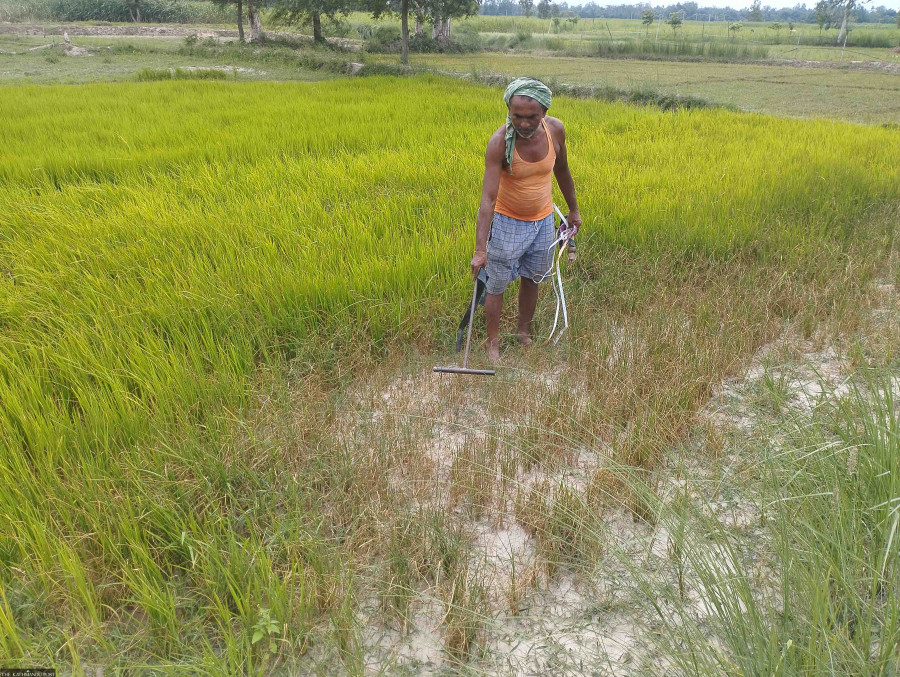Money
Drought parches Nepal’s agricultural heartland
Government statistics show that paddy transplantation in Madhesh has been progressing at a slow pace for lack of rain.
Sunita Baral, Shankar Acharya & Awadhesh Kumar Jha
Rajeshwor Yadav's green paddy fields have turned yellowish for lack of water. Nepali farmers depend on the sky for water to grow their crops, and no rain means big problem for them.
"This is a very bad season, the worst for us," said Yadav of Sonma Rural Municipality-7 in Mahottari district in Madhesh province, southeast Nepal.
Yadav's family depends on paddy for their livelihood, so it is important that they have a good crop. There was no rain at the beginning of the paddy season, but he had hoped that the heavens would start to pour by July or August.
"The rains didn’t arrive. So I spent Rs18,000 to buy pipes to pump water out of the ground using a boring machine.” He installed 400 meters long pipe to a deep-bore well and connected the paddy fields.
But the well dried up, and without water, his fields started to crack and the paddy saplings became yellowish.
Madhesh, a major food producing province, is reeling under a severe drought, raising the possibility of a full-blown humanitarian crisis at a time when Nepal's economy is going through its biggest shock in decades.
The monsoon is crucial for the country's Rs5.38-trillion economy, as it brings nearly 80 percent of the rain needed by farms, besides replenishing reservoirs and aquifers.
The 25th session of the South Asian Climate Outlook Forum (SASCOF-25) showed that Bagmati and Madhesh provinces may receive normal rainfall.
But Yadav says there is no rain. Last year, he had finished transplanting paddy on his fields by the end of July. Due to the drought this year, he has been able to transplant paddy on only 5 kattha of his 2-bigha farm.
“It has been more than a decade that we have been facing the problem of water,” said Yadav. This year, the situation has become severe because even the wells have gone dry.
“We have not faced this kind of water scarcity before,” said Yadav who has been engaged in farming for the last four decades. He is worried about earning enough to feed his six-member family.
Another farmer Bikram Sah of Gaushala-7, Manharwa could not transplant paddy on his 1-bigha farm after his water sources dried up. He is now having problems finding water for even drinking.
“All tube wells, wells, deep borings and ponds in the village have dried up. The villagers are running around in search of drinking water,” said Sah.
Other farming villages across the district, which is considered to be the country's agricultural heartland, are experiencing similar distress.
Rice growers face a drastic drop in their incomes because their farms are lying barren during the year's most important growing season. Those who managed to transplant paddy too are suffering because lack of water has made their green fields yellow.
Government statistics show that paddy transplantation in Madhesh has been progressing at a slow pace, reaching just 60 percent as of August 4. The province possesses 410,650 hectares of fields suitable for planting paddy, but transplantation has been completed on only 242,507 hectares.
In the same period last year, farmers had completed transplantation on 80 percent of the fields.
Though rainfall was normal last year, farmers suffered a drop in paddy production due to lack of chemical fertilisers. As a consequence, they are having money problems now.
Roshan Mehta, spokesperson for the provincial Ministry of Land Management, Agriculture and Cooperatives, said the transplanted paddy saplings had started drying up due to lack of irrigation. "This is a case of extreme drought,” he said.
As of the first week of August, paddy transplantation had been completed on only 20 percent of the rice fields in Mahottari among the eight districts in the province.
In the rest of the provinces, the transplantation rate was 70 percent in Parsa, 80 percent in Bara, 90 percent in Rautahat, 57 percent in Sarlahi, 31 percent in Dhanusha, 55 percent in Siraha and 85 percent in Saptari.
The District Disaster Management Committee has decided to declare eight districts as being drought-hit and initiate measures to issue compensation to the affected farmers.
Chure conservation activist Nagdev Yadav said that since there was inadequate rainfall this monsoon, not only have the paddy fields remained barren, but the people are seeing their underground drinking water sources dry up too.
Surendra Prasad Kurmi, information officer of the Agriculture Knowledge Centre in Parsa, said that paddy transplantation had not been done on 40 percent of the fields in the southern areas of Parsa like Birgunj, Bindabasini, Pakahamainpur, Kalikamai and Thori.
There was sporadic rainfall last Friday, but it was not enough to replenish the groundwater aquifers.
In northern Parsa, paddy transplantation is being done with water from the Gandak canal.
In Saptari, about 15 percent of the paddy fields are barren, and the fields where paddy has been transplanted are developing cracks for lack of water.
Rajendra Prasad Yadav, chief of the Agriculture Knowledge Centre in Saptari, said paddy transplantation had been completed on 68,000 hectares out of the 72,000 hectares of paddy fields.
"But that is nothing to cheer about because the transplanted paddy plants are dying for lack of water, he said.
During the same period last year, 96 percent of the paddy transplantation had been completed in Saptari.




 27.12°C Kathmandu
27.12°C Kathmandu
















